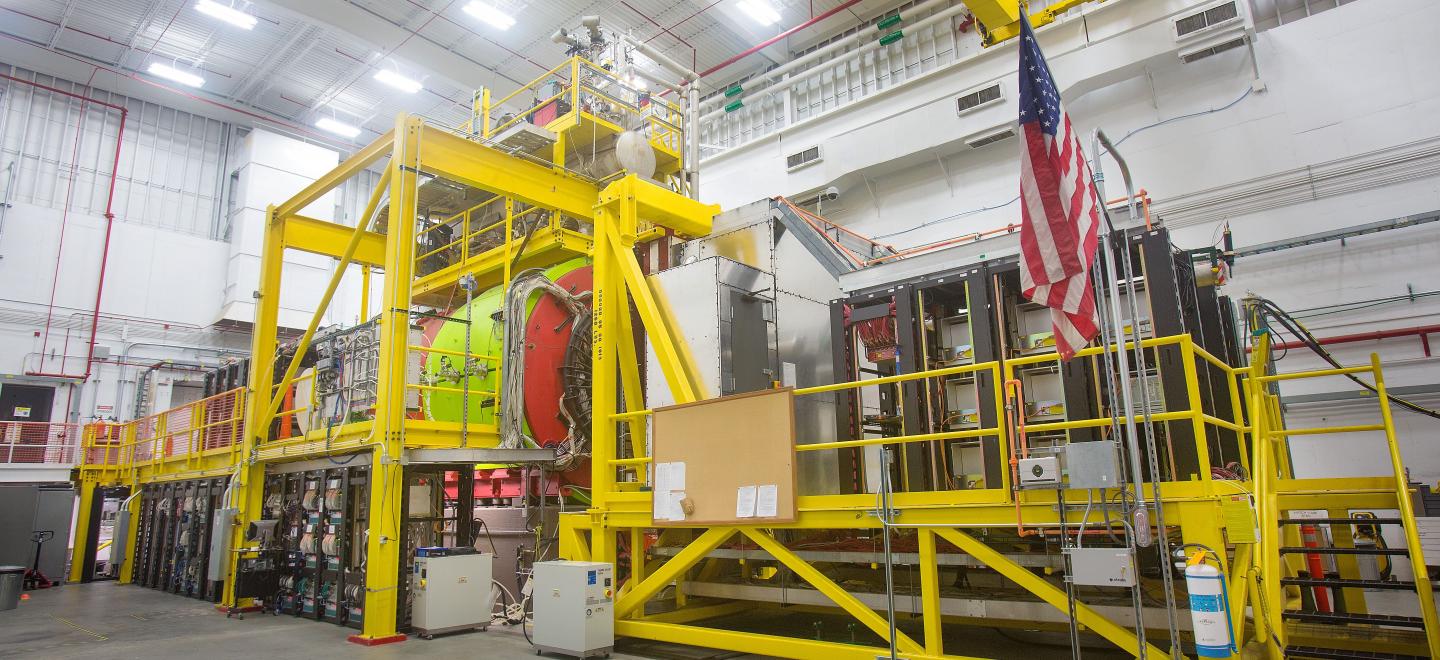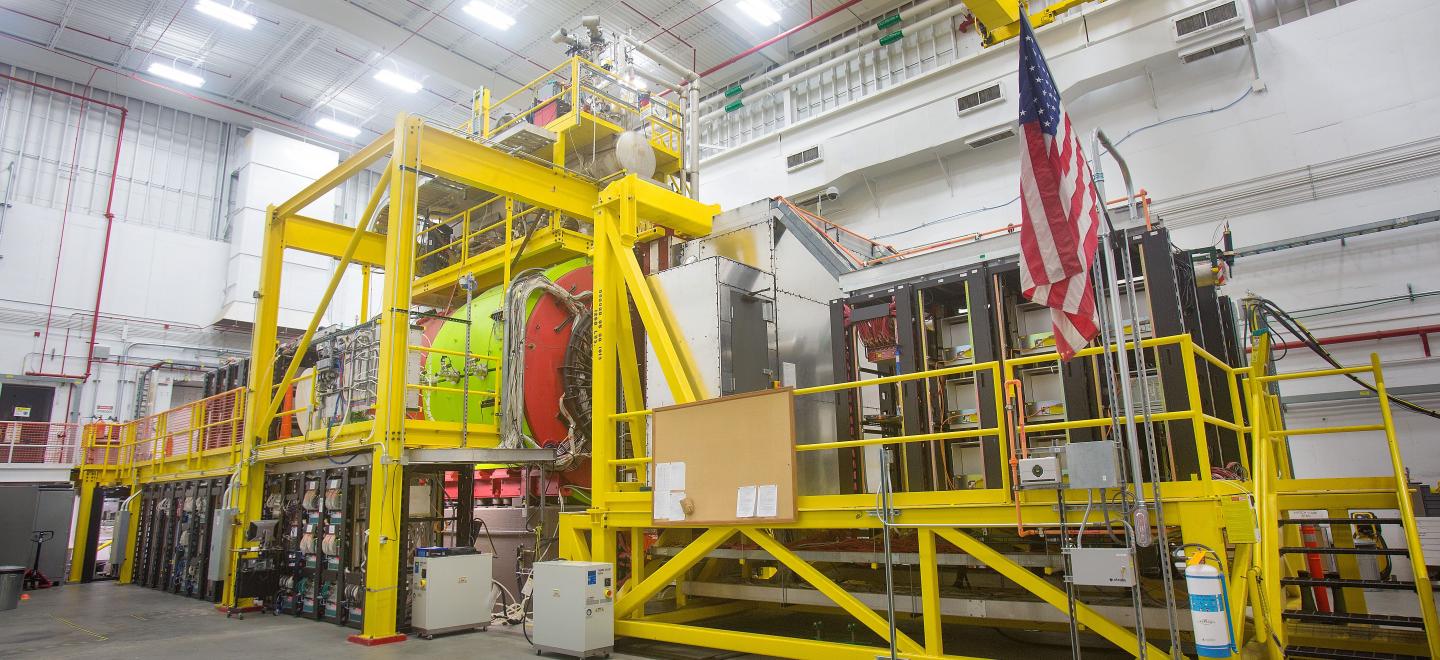
Credit: DOE's Jefferson Lab
The first experimental result has been published from the newly upgraded Continuous Electron Beam Accelerator Facility (CEBAF) at the U.S. Department of Energy's Thomas Jefferson National Accelerator Facility. The result demonstrates the feasibility of detecting a potential new form of matter to study why quarks are never found in isolation.
The 12 GeV CEBAF Upgrade is a $338 million, multi-year project to triple CEBAF's original operational energy for investigating the quark structure of the atom's nucleus. The majority of the upgrade is complete and will be finishing up in 2017.
Scientists have been rigorously commissioning the experimental equipment to prepare for a new era of nuclear physics experiments. These activities have already led to the first scientific result, which comes from the Gluonic Excitations Experiment. GlueX conducts studies of the strong force, which glues matter together, through searches for hybrid mesons.
According to Curtis Meyer, a professor of physics at Carnegie Mellon University and spokesperson for the GlueX experiment at Jefferson Lab, these hybrid mesons are built of the same stuff as ordinary protons and neutrons, which are quarks bound together by the "glue" of the strong force. But unlike ordinary mesons, the glue in hybrid mesons behaves differently.
"The basic idea is that a meson is a quark and antiquark bound together, and our understanding is that the glue holds those together. And that glue manifests itself as a field between the quarks. A hybrid meson is one with that strong gluonic field being excited," Meyer explains.
He says that producing these hybrid mesons allows nuclear physicists to study particles in which the strong gluonic field is contributing directly to their properties. The hybrid mesons may ultimately provide a window into how subatomic particles are built by the strong force, as well as "quark confinement" – why no quark has ever been found alone.
"We hope to show that this "excited" gluonic field is an important constituent of matter. That's something that has not been observed in anything that we've seen so far. So, in some sense, it's a new type of hadronic matter that has not been observed," he says.
In this first result, data were collected over a two-week period following equipment commissioning in the spring of 2016. The experiment produced two ordinary mesons called the neutral pion and the eta, and the production mechanisms of these two particles were carefully studied.
The experiment takes advantage of the full-energy, 12 GeV electron beam produced by the CEBAF accelerator and delivered into the new Experimental Hall D complex. There, the 12 GeV beam is converted into a first-of-its-kind 9 GeV photon beam.
"The photons go through our liquid hydrogen target. Some of them will interact with a proton in that target, something is exchanged between the photon and the proton, and something is kicked out – a meson," Meyer explains. "This publication looked at some of the simplest mesons you could kick out. But it's the same, basic production mechanism that most of our reactions will follow."
The result was published as a Rapid Communication in the April issue of Physical Review C. It demonstrated that the linear polarization of the photon beam provides important information by ruling out possible meson production mechanisms.
"It's not so much that the particles we created were interesting, but how they were produced: Learning what reactions were important in making them," Meyer says.
The next step for the collaboration is further analysis of data already collected and preparations for the next experimental run in the fall.
"I'm sure that we've produced hybrid mesons already, we just don't have enough data to start looking for them yet," Meyer says. "There are a number of steps that we're going through in terms of understanding the detector and our analysis. We're doing the groundwork now, so that we'll have confidence that we understand things well enough that we can validate results we'll be getting in the future."
"This new experimental facility – Hall D – was built by dedicated efforts of the Jefferson Lab staff and the GlueX collaboration," says Eugene Chudakov, Hall D group leader. "It is nice to see that all of the equipment, including complex particle detectors, is operating as planned, and the exciting scientific program has successfully begun."
The 12 GeV CEBAF Upgrade project is in its last phase of work and is scheduled for completion in September. Other major experimental thrusts for the upgraded CEBAF include research that will enable the first snapshots of the 3D structure of protons and neutrons, detailed explorations of the internal dynamics and quark-gluon structure of nuclei, and tests of fundamental theories of matter.
###
Jefferson Lab is supported by the Office of Science of the U.S. Department of Energy. The Office of Science is the single largest supporter of basic research in the physical sciences in the United States, and is working to address some of the most pressing challenges of our time. For more information, please visit science.energy.gov.
Jefferson Science Associates, LLC, a joint venture of the Southeastern Universities Research Association, Inc. and PAE, manages and operates the Thomas Jefferson National Accelerator Facility, or Jefferson Lab, for the U.S. Department of Energy's Office of Science.
Media Contact
Kandice Carter
[email protected]
757-269-7263
@Jblab
http://www.jlab.org
############
Story Source: Materials provided by Scienmag





